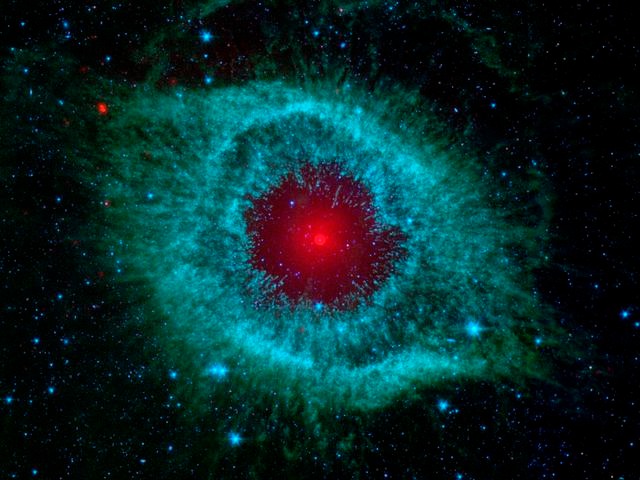The demise of a star does not mark its end; rather, it signifies a new beginning—the start of its immortality. This is nothing but a cosmic metamorphosis that enriches the universe, forming the essential elements that are crucial for the creation of new celestial bodies in the cosmos. The manner in which the life of a star culminates primarily depends on its initial mass, leading to the diverse phenomena of the cosmos. Low- to intermediate-mass stars, with masses up to eight solar masses, conclude their life cycle by forming planetary nebulae, shedding their outer layer, and leaving behind white dwarfs. However, massive stars with masses greater than eight solar masses cease their cycle by potentially converting into either a neutron star or a black hole.
The Life Cycle of a Star
The life cycle of a star can be fragmented into three phases: formation, main sequence, and death. Stars are born in nebulae, vast, thick, and dense clouds of gas. In the grip of gravity, these massive clouds collapse, originating a protostar. When the temperature of the protostar’s core exceeds ten million degrees Celsius, nuclear fusion ignites, transforming hydrogen into helium while discharging tremendous energy into the cosmos. This signifies the birth of a star. Next comes the main sequence phase, during which a star spends most of its life. Stars endure most of their lives combining hydrogen into helium in their cores. However, when a star depletes its hydrogen fuel, it steps into its final stage, leading to various end states depending on its mass.
The Quiet Death: Low-Mass Stars

The death of low-mass stars is a calm and gradual process. As these stars run out of hydrogen fuel, their core condenses and heats up, leading to the enlargement of the outer layers. The star becomes a red giant, with its outer envelope dispersing. The dispersed and ejected exterior layers form a sparkling shell of ionized gas called a planetary nebula, leaving a residue in the star’s hot core.
The residue core, now a white dwarf, is incredibly dense and composed mainly of oxygen and carbon. It relinquishes heat slowly over billions of years.
The Explosive End: High-Mass Stars
When massive stars run out of their hydrogen fuel, they face catastrophic and tumultuous conclusions.
Supernova Explosions
When a colossal star drains its nuclear fuel, its core implodes under the strength of gravity, initiating a supernova explosion. These explosions release tremendous energy that can outshine an entire galaxy for a brief period.
Supernovae are considered the most energetic events of the cosmos; they play a pivotal role in the cosmic cycle. The combustion dissipates heavy elements like iron, gold, and uranium into space, which are now part of stars, planets, and even living organisms.
Neutron Stars and Pulsars

What is left behind after a supernova depends on the mass of the original star. If the disintegrating core has a mass between 1.4 and 3 solar masses, it will form a neutron star. A neutron star is a dense object composed entirely of neutrons.
Neutron stars are incredibly exotic, with magnetic fields trillions of times more potent than Earth’s. Neutron stars have densities analogous to atomic nuclei; a tablespoon of neutron star material carries a mass of about 4 billion tons. Several neutron stars gyrate intensely, emanating beams of radiation, and are known as pulsars.
Black Hole Formation
For many massive stars, the implosion of the core does not end at the neutron star stage. If the core surpasses three solar masses, it will proceed to implode, forming a black hole. Black holes are a region of space-time where gravity is so intense that even light cannot escape. The perimeter, from which nothing can escape, is known as the event horizon.
Black holes can enlarge by accumulating matter or merging with other black holes. Black holes represent the culmination for most massive stars. Their existence in the cosmos has substantial ramifications for the structure and evolution of galaxies.
The Cosmic Significance of Stellar Demise

The demise of a star is a cosmic phenomenon that holds monumental significance. It marks the end of one chapter and the beginning of another. Whether it ends as a serene supernova or a turbulent black hole, the stellar death truly enriches the universe, seeding it with the elements that are indispensable for both life and astronomical objects.
As we gaze at the night sky, we are not just observing distant light but the enduring cosmic evolution. In the words of the famous astronomer Carl Sagan, “We are made of star stuff.” The demise of a star is not merely a cosmic event but a fundamental part of our own existence, bridging us to the vast and mysterious universe where we live.

















It’s a true beauty that we can see soo much life happening just by gazing at the night sky. And furthermore its amazing how human curiosity forces us to leave every worry aside and seek greater knowledge of the cosmos. Truly an amazing work that pulls that same desire to learn out of the reader!